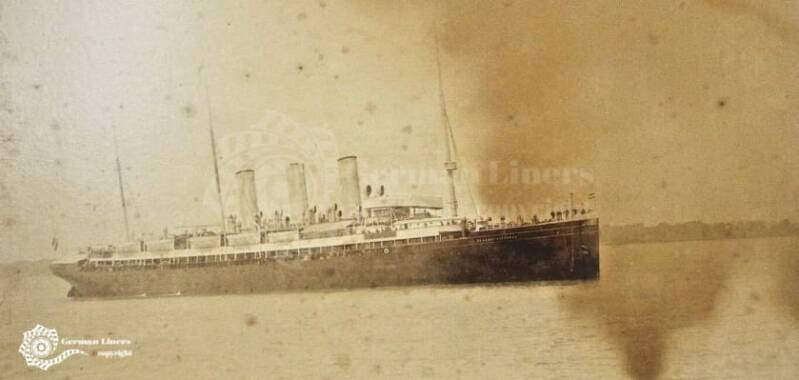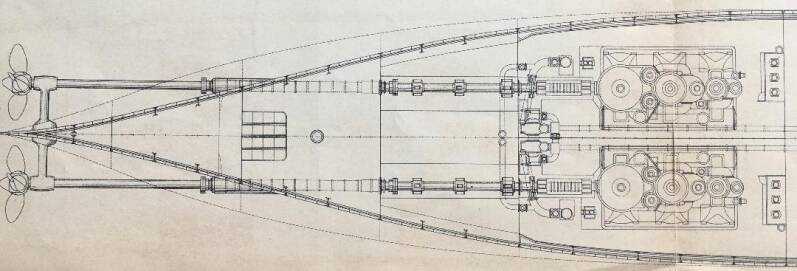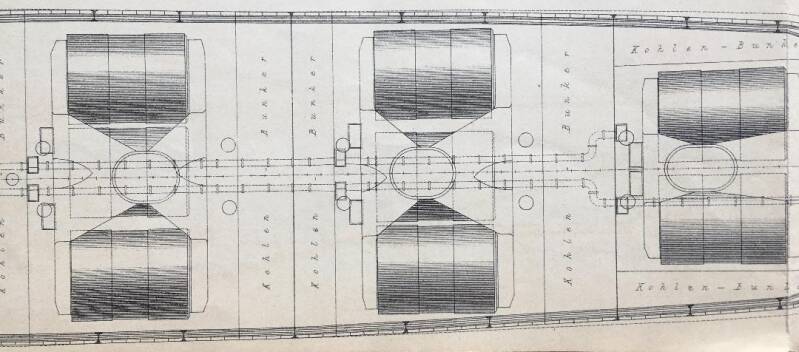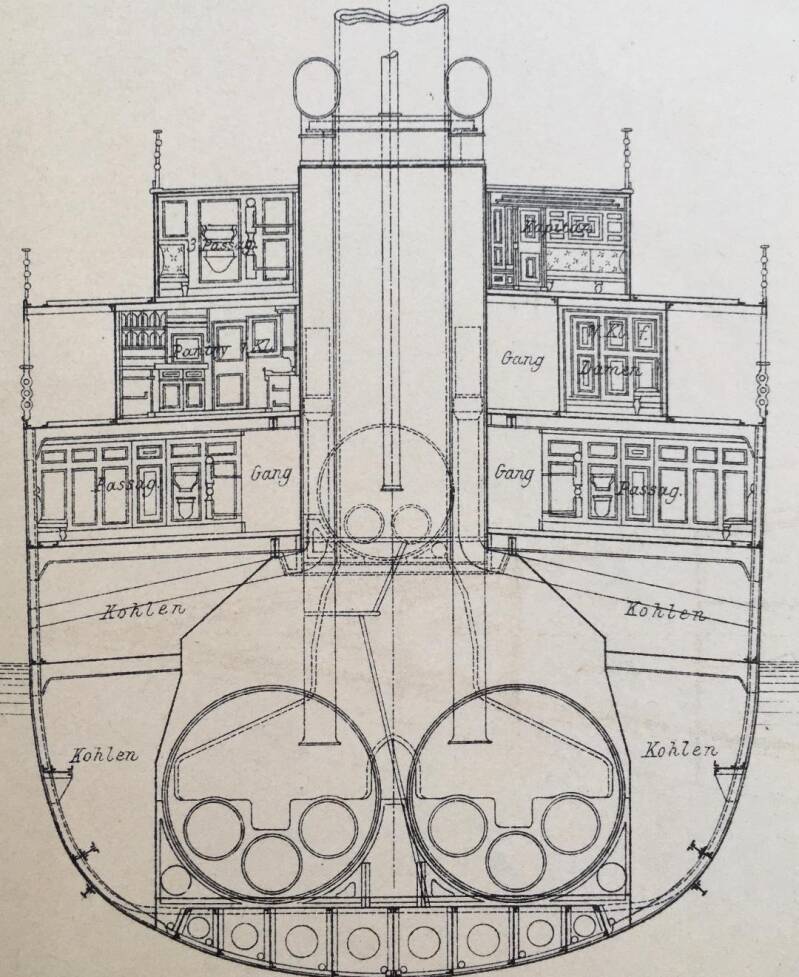THE "AUGUSTA VICTORIA CLASS" SCHNELLDAMPFER
The start of the Hamburg-Amerikanische Packetfahrt-Actien-Gesellschaft schnelldampfer era.
When Direktor Albert Ballin joined the HAPAG on 1 May 1886 at the age of 29, it would be under his wings that HAPAG would turn out to be one of the world's leading shipping companies within the next 30 years. Bringing HAPAG to the North Atlantic soon became Albert Ballins' prime strategy. After having convinced the board on the urgency of developing schnelldampfer, it became evident that HAPAG could only reach it's goals by changing it's strategy and technical position, which would mean reconsidering which shipyard would be able to offer the best possible technical development at the lowest costs. This led to the HAPAG contacting Direktor Haack, of the Vulcan Stettin Shipyard in March 1883.
In 1883 Hapag Direktor John Meyer approached various shipyards to reflect on their visions about the development of a new schnelldampfer. Quite sensational was the fact Hapag by then already had foreseen the development of the doppelschrauben schnelldampfer.

The Augusta Victoria was the first ship of the Augusta Victoria Class and is shown here in a beautiful advert published by H.A.P.A.G. in the year 1890.
Restrictions in draft in order to keep the ability of manoeuvring the ships on the river Elbe as well as technical issues to keep the new type of ships safe were the biggest challenge for the shipping company. At a board meeting on 6 October 1884, Hapag discussed the various offers and ideas sent by the shipyards that were contacted. The Napier Shipyard in Glasgow turned out to be the cheapest at 3.136 Million Mark, the Vulcan Shipyard Stettin the most expenssive at 3.720 Million Mark.

Albert Ballin already had convinced the board about the urgency of the new type of schnelldamper and in the board meeting held on 6 October 1887 it was decided that the new type of "doppelschrauben schnelldampfer" would be built.
The contracts for two newbuildings were awarded to the Laird Bros. Shipyard in Birkenhead and the A.G.Vulcan Shipyard Stettin according to detailed plans from H.
Hapag took significant risks concerning the choiche to develop a doppelschrauben schnelldampfer, as this was
The Augusta Victoria seen in her original livery on the river Elbe downstream.
something completely new and there were no studies
available and there was no experience with this type of propulsion. Even more risk was taken with awarding the built to the German Vulcan Stettin Shipyards, as German shipyards didn't have any experience on building ships of this size, as the Atlantic scene was dominated by other countries and Germany didn't play any big role in it. The long contract negotiations with the Vulcan succeeded finally only in bank gurantees to safeguard teh financial position of Hapag in case that the new vessel would not meet the contractual conditions during trials.
By coincidence however the British Inman & International Line already ordered somewhat earlier in 1887 two twin screw liners of wich City of New York was the first such vessel completed and successfully performed her maiden voyage from Liverpool to New York in August 1988. The first Hapag liner with the innovative doppelschrauben propulsion named Augusta Victoria was ready for her maiden voyage only in May 1889. It is therefore not unlikely that Albert Ballin got to know about Inman Line's plans of the new advanced technology considering his contacts to British shipowners. Broken crankshafts or a lost or damaged propeller or e were not uncommon casualties of the single screw schnelldampfer on the North Atlantic so that the new concept woud bring passengers, crew and shipowners an important advantage of operational safety. Even a lost or broken rudder would still ensure maneuverability by steering only with twin screws.

The two engine units of the Auguste Victoria ready to be hoisted on board seen here at the workshop of the Vulcan yard in Stettin.
Augusta Victoria was launched on December 1, 1888 and the christening speech held by Antonie Nissen, daughter of the chairman of the Hapag advisory board. After completion of the vessel in spring 1889 first trials revealed that the required speed of 19 kn (at 12.500 PSi) could not be fully reached with 18,7 kn equivalent to 12.280 PSi., but nevertheless was deliverd to Hapag on April 24, 1889. Her maiden voage from Hamburg to New York started on May 10. Augusta Victoria and her sister Columbia from Laird Brothers - ready for the maiden trio on July 18, 1889, proved to become an instant success by the public . Hapag had no worries about bookings and found itself in the front range of the international North Atlantic shipowners. At the end of the North Atlantic season Augusta Victoria was drydocked in Tilbury for a fresh underwater hull painting and improvements to the boiler room ventilation were made for a higher stokers performance to produce the required steam. The vessel now reached the contract speed by running six hours with 19 kn and was finally accepted by Hapag from the Vulcan yard.
British liners held the Blue Ribband ever since 1838 when the Sirius achieved the first such 'record' with a crossing time of 18 days and a speed of 8kn ! Huge technical development
progressed in the meantime and in 1889 with Augusta Victoria put into service her main competitors enroute from Hamburg via Southampton to New York were North German Lloyd and the French Compagnie Gernerale Transatlantique (CGT). The travelling public acknowleged the luxury accomodation and speed paird with safety and high performance of the new twin-screw ('doppelschrauben') propulsion of both newHapag liners. The current speed record however was still held under the Union Jack by the City of Paris of Inman with 20,03 kn, but the British liners like Cunard, Inman and White Star were all running from Liverpool to New York. This meant no interference for the competitive situation with the German and French liners calling Southampton.

Augusta Victoria as built originally. Main particulars of the boiler rooms and engines as well as the bridge deck with social rooms, some first class cabins and the lifeboats can be identified from this fine drawing to get a first impression of her size. Click "Strg and +" to enlarge the drawing. (Courtesy of: Zeitschrift des Vereins Deutscher Ingenieure VDI 1890)
Compared to the Flüsse-class passenger vessels from Norddeutscher Lloyd (nine ships built between 1881 and 1887) the Augusta Victoria-class had three meters of additional width neccesary to install the two engine units (see above illustration). The first two vessels had ten meters more in length, while the other two of the Hapag quartet Normannia and Fürst Bismarck of 1890 resp. 1891) showed 25m additional length much to the benefit of a more spacious passenger accomodation.
The remarkable inovation of the new Hapag schnelldampfer was - as already mentioned - the twin screw propulsion, which immedaitely outclassed the Lloyd liners as the main competitor of Hapag and also in regards to speed: while the Lloyd vessels run on average service speed of abt 16,5 kn were the Hapag quartet with abt. 18,5 kn considerably faster. Only for the British Inman Comp. two such doppelschrauben liners were introduce shortly before Augusta Victoria came into service as the third vessel with this latest state of the art system. Innovative as well was the complete separation of the two engines by a longitudinal bulkhead between the two compartments carried right up to the upper deck with separate skylights.

Longitudinal drawings of Augusta Victoria with the layout of the double engines with shaft tunnels and the two threebladded propellers of bronze.
Below: arrangement of the eight boilers, two pairs of 3 and one with 2 boilers and coal bunkers. (Courtesy: VDI-Zeitschrift 1890)




The left section of the vessel illustrates the enormous size and height of both engines mounted in completely separate compartments up to the skylights. The midships section shows three boilers in a row while more towards the bow with a slender hull the was space only for two boilers next to each other. (Courtesy VDI-Zeitschrift 1890)
